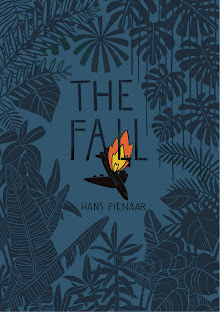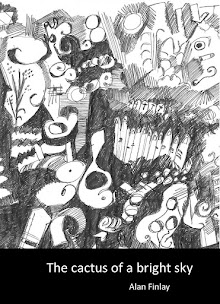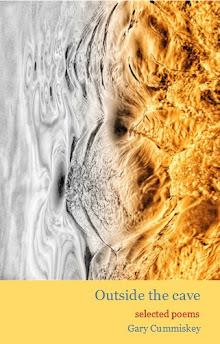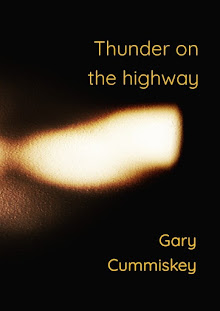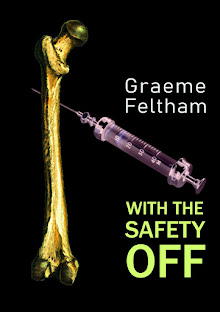Sunday, 31 July 2011
Pphoo - 1988
Pphoo is a trilingual (English, French, Bangla) literary journal published by Kolkata-based poet Pradip Choudhuri. This 1988 issue includes writers such as Charles Plymell, Claude Pelieu, George Dowden and FA Nettelbeck. The cover art is fragmented ink by Theo Green, who also contributes a piece about visitng Brion Gysin, as well as a prose reverie about Tangier. There is also a sizeable section devoted to "Le Mythe Kerouac".
Friday, 29 July 2011
Sunday, 24 July 2011
Black Alephs by Jack Hirschman
Jack Hirschman's Black Alephs: Poems 1960-1968, published by Trigram Press, London, 1969. Cover and inside art by Wallace Berman.
Labels:
Black Alephs,
Jack Hirschman,
poetry,
Trigram Press,
Wallace Berman
Thursday, 21 July 2011
Gail Dendy's Closer Than That on Peony Moon
Closer Than That by Gail Dendy
ISBN: 978-0-9869982-0-1
Soon to be published by Dye Hard Press, Closer Than That will be available from bookstores countrywide at an estimated retail price of R105.
A sample of poems from the collection appear on Peony Moon.
ISBN: 978-0-9869982-0-1
Soon to be published by Dye Hard Press, Closer Than That will be available from bookstores countrywide at an estimated retail price of R105.
A sample of poems from the collection appear on Peony Moon.
Labels:
Closer Than That,
Gail Dendy,
Peony Moon
Podcast of Arja Salafranca interviewed about The Edge of Things
Arja Salafranca was interviewed by Sue Grant-Marshall about The Edge of Things on the Reading Matters programme for Radio Today on July 14th. You can listen to the podcast of the interview here.
Wednesday, 20 July 2011
Kate Turkington reviews The Edge of Things
 Short stories, as any writer knows, are possibly the most difficult literary form. In the space of a few pages, the storyteller must condense the thoughts, feelings and actions of his or her characters and then come to a conclusion.
Short stories, as any writer knows, are possibly the most difficult literary form. In the space of a few pages, the storyteller must condense the thoughts, feelings and actions of his or her characters and then come to a conclusion. The Edge of Things (Dye Hard Press) edited by Arja Salafranca, herself an award-winning poet and short storyteller, gives us the best of contemporary South African writers. There are many themes with many twists.
The title story The Edge of Things by Jenna Mervis marries stark everyday South African reality to a wondrous fantasy. Arja’s own story The Iron Lung reminds us that imprisonment is not only physical but emotional and spiritual. The Company Christmas Party by Hamilton Wende is about that tender first love, and Mr Essop by Pravasan Pillay tells the story of a charming old Indian pensioner who rents a cottage on a friend’s property with unforeseen circumstances. The stories are dazzlingly diverse: funny, sad, thought-provoking and relevant. Keep them by your bed or in your bag for those school lift waits.
Published on http://www.joburg.co.za/ here
Monday, 18 July 2011
Detroit by Philip Hammial
Detroit - the latest collection of poems by Australian poet and artist Philip Hammial, published by the Island Press Co-operative, New South Wales, 2011.
Thursday, 14 July 2011
Loneliness a recurring theme in this collection: a review of The Edge of Things, by Gwen Podbrey
The short story has come back into its own over the past few years, possibly because time-strapped readers find them easier to manage than a lengthy novel.
This collection includes contributions from a remarkably diverse range of writers, including Gail Dendy, Jenna Mervis, Gillian Schutte and Jayne Bauling.
If there is one central theme to the book, it is alienation (or, to use real name, loneliness). The stories capture encounters and experiences which tilt us over into the cracks between the crevices of contemporary life: those dark, uncharted spaces where needs are failed by niceties, and pain and perdition walk hand in hand.
Pick of the crop – by a long way – is Bernard Levinson’s superb “Tokai”, which recounts his delivery of an Afrikaans couple, the Bezuidenhout’s, baby in the dead of night. But the birth is complicated and the womb goes into violent contractions, forcing him to manually secure it and staunch its gushing of blood.
For hours he sits, his hand in the uterus of his semi-comatose patient, feeling this incubator of life convulse, enfold his fingers and relay to him its arcana.
“There was a slight shift of tempo. I listened with the fingers of my fist. Unmistakably, I heard the womb flutter and shift itself minutely over my fist... It stretched and gripped. Stretched again and squeezed my fist firmly. I inched my hand out. A secret dialogue between my hand and the womb. My blunt fist - mute and solid. The womb excited, chattering and intimately pressing and caressing my hand.”
Witnessing the drama of this birth - like the primordial one and, indeed, all births - Kleinman Bezuidenhout is engulfed in agony as acute as his wife’s. The next morning, Levinson - preparing to leave - sees him engaged in a ritual which matches, in every detail, the intensity and power of the previous night’s crisis.
The story is an unforgettable glimpse into the soul of the healer, whose patients’ trust in him can crucify as often as it coronates, and whose brief role in their lives - as an outsider, observing and intervening, but never sharing - carries a unique loneliness.
Later, in Liesl Jobson’s “You Pay for the View: Twenty Tips for Super Pics”, we enter the alienation of a compulsive photographer unable to fully engage with her life, and attempting instead to capture its essence through her lens “because the camera never lies”.
Yet it does, for it lacks the vocabulary to capture the truth of locations and individuals, how they imbed themselves in the DNA of the soul and remain there forever, a testimony to life and loss. These are not within the province of pixel and resolution, but of another documenting medium altogether.
The third exceptional story in the collection, Pravasan Pillay’s “Mr Essop”, recounts the arrival of a seemingly kindly, placid lodger at his parents’ home. The author, still a child, notes the growing friendship between the boarder (Mr Essop) and his father - both lonely men - and their mutual pleasure at discovering the values they have in common. But when Essop suddenly shows a brutal side to his nature, shock is added to disappointment.
Aryan Kaganof’s “Same Difference” explores yet another kind of alienation: that of drug users, whose subculture and exclusion from mainstream society force them to band together, unwillingly recognising in each other kindred tortured spirits and putting on a show of bravado to conceal their desperation.
In this ugly, treacherous world, the only allegiances which matter, last as long as it takes to shoot up a crystal meth hit.
“The upstairs toilets are for blowjobs and the schnarf sessions. The outside toilets are for quick shags and schnarf sessions … Tretchikoff girls clustered on the walls and in the mirror. Looking down serenely on the useless lives of all the pastel customers. Useless, all of it. Useless.”
As the narrator ends yet another all-night session with his gang of users in the fetid, filthy basement of a nightclub, and the sun announces the break of yet another unwelcome day, he reflects: “I’m frightened. I’m lonely. Sometimes I feel close to death. But at least I scored tonight… There is no reason to stay alive. But I refuse to bribe the reaper to come and take me.”
Hans Pienaar’s contribution, Telephoning the Enemy”, makes a brave, but failed, effort to explore the alienation of white, apartheid-bound South Africans on the verge of political change. As bombs hidden in sidewalk garbage cans claim one civilian victim after another during the early 1980s, racist beliefs are heightened and the gap between terrorist and victim appears unbreachable.
Not all the stories have the gravitas or compositional skill to sustain the reader’s interest. Angelina N Sithebe’s cumbersome, melodramatic and poorly structured “Sepia”, for example, features characters who are utterly implausible, while Rosemund Handler’s “Clueless” exhumes a stale, clichéd story line: white, lonely madam coming on to a man across the colour bar, followed by a delicious explosion of eroticism and new awareness of each other as human beings. Hardly groundbreaking stuff.
Still, with 22 out of 24 stories offering piercing insights and showcasing a range of exciting writing talent, the collection is one of the best to emerge in recent years. Salafranca’s eloquent and moving foreword whet one’s appetite for the feast to come and the contributors’ profiles at the back of the book give perspective to the voices on the pages, which demand - and deserve - an audience.
(Published in SA Jewish Report, July 8, 2001)
This collection includes contributions from a remarkably diverse range of writers, including Gail Dendy, Jenna Mervis, Gillian Schutte and Jayne Bauling.
If there is one central theme to the book, it is alienation (or, to use real name, loneliness). The stories capture encounters and experiences which tilt us over into the cracks between the crevices of contemporary life: those dark, uncharted spaces where needs are failed by niceties, and pain and perdition walk hand in hand.
Pick of the crop – by a long way – is Bernard Levinson’s superb “Tokai”, which recounts his delivery of an Afrikaans couple, the Bezuidenhout’s, baby in the dead of night. But the birth is complicated and the womb goes into violent contractions, forcing him to manually secure it and staunch its gushing of blood.
For hours he sits, his hand in the uterus of his semi-comatose patient, feeling this incubator of life convulse, enfold his fingers and relay to him its arcana.
“There was a slight shift of tempo. I listened with the fingers of my fist. Unmistakably, I heard the womb flutter and shift itself minutely over my fist... It stretched and gripped. Stretched again and squeezed my fist firmly. I inched my hand out. A secret dialogue between my hand and the womb. My blunt fist - mute and solid. The womb excited, chattering and intimately pressing and caressing my hand.”
Witnessing the drama of this birth - like the primordial one and, indeed, all births - Kleinman Bezuidenhout is engulfed in agony as acute as his wife’s. The next morning, Levinson - preparing to leave - sees him engaged in a ritual which matches, in every detail, the intensity and power of the previous night’s crisis.
The story is an unforgettable glimpse into the soul of the healer, whose patients’ trust in him can crucify as often as it coronates, and whose brief role in their lives - as an outsider, observing and intervening, but never sharing - carries a unique loneliness.
Later, in Liesl Jobson’s “You Pay for the View: Twenty Tips for Super Pics”, we enter the alienation of a compulsive photographer unable to fully engage with her life, and attempting instead to capture its essence through her lens “because the camera never lies”.
Yet it does, for it lacks the vocabulary to capture the truth of locations and individuals, how they imbed themselves in the DNA of the soul and remain there forever, a testimony to life and loss. These are not within the province of pixel and resolution, but of another documenting medium altogether.
The third exceptional story in the collection, Pravasan Pillay’s “Mr Essop”, recounts the arrival of a seemingly kindly, placid lodger at his parents’ home. The author, still a child, notes the growing friendship between the boarder (Mr Essop) and his father - both lonely men - and their mutual pleasure at discovering the values they have in common. But when Essop suddenly shows a brutal side to his nature, shock is added to disappointment.
Aryan Kaganof’s “Same Difference” explores yet another kind of alienation: that of drug users, whose subculture and exclusion from mainstream society force them to band together, unwillingly recognising in each other kindred tortured spirits and putting on a show of bravado to conceal their desperation.
In this ugly, treacherous world, the only allegiances which matter, last as long as it takes to shoot up a crystal meth hit.
“The upstairs toilets are for blowjobs and the schnarf sessions. The outside toilets are for quick shags and schnarf sessions … Tretchikoff girls clustered on the walls and in the mirror. Looking down serenely on the useless lives of all the pastel customers. Useless, all of it. Useless.”
As the narrator ends yet another all-night session with his gang of users in the fetid, filthy basement of a nightclub, and the sun announces the break of yet another unwelcome day, he reflects: “I’m frightened. I’m lonely. Sometimes I feel close to death. But at least I scored tonight… There is no reason to stay alive. But I refuse to bribe the reaper to come and take me.”
Hans Pienaar’s contribution, Telephoning the Enemy”, makes a brave, but failed, effort to explore the alienation of white, apartheid-bound South Africans on the verge of political change. As bombs hidden in sidewalk garbage cans claim one civilian victim after another during the early 1980s, racist beliefs are heightened and the gap between terrorist and victim appears unbreachable.
Not all the stories have the gravitas or compositional skill to sustain the reader’s interest. Angelina N Sithebe’s cumbersome, melodramatic and poorly structured “Sepia”, for example, features characters who are utterly implausible, while Rosemund Handler’s “Clueless” exhumes a stale, clichéd story line: white, lonely madam coming on to a man across the colour bar, followed by a delicious explosion of eroticism and new awareness of each other as human beings. Hardly groundbreaking stuff.
Still, with 22 out of 24 stories offering piercing insights and showcasing a range of exciting writing talent, the collection is one of the best to emerge in recent years. Salafranca’s eloquent and moving foreword whet one’s appetite for the feast to come and the contributors’ profiles at the back of the book give perspective to the voices on the pages, which demand - and deserve - an audience.
(Published in SA Jewish Report, July 8, 2001)
Tuesday, 12 July 2011
Short but rich South African view - a review of The Edge of Things by Jane Rosenthal
African Pens 2011, Jacana
Though they may have been somewhat neglected in recent years, there is a long tradition of short stories in South African fiction. Some of the most famous writers are Pauline Smith, Can Themba and Dan Jacobson; more recently Ivan Vladislavic, David Medalie and Zoe Wicomb spring to mind. Practitioners of this form were hard at work last year if one judges by the two collections reviewed here. As with literary awards for fiction, it's a matter of some chance as to what appears in any given year and 2010 seems to have been particularly good.
Arja Salafranca originally intended The Edge of Things to be a special short-fiction edition of the journal Green Dragon, but as she had so many submissions, it became a full-length book. This interesting and wide-ranging selection reflects the richness of the South African experience. It begins with several pieces that delineate the complexities of personal relationships, including mothers and daughters, dysfunctional marriages and the interior lives of women - all situations in which the protagonists seem to be sailing close to the edge of things.
The title piece, The Edge of Things by Jenna Mervis, is a particularly fine story about a woman and her dog, alone in a remote place, which is beset by fear and fantasy.
Other strong but even darker pieces include Tokai by Bernard Levinson, a brooding, sexualised and masculien take on birth; Telephoning the Enemy by Hans Pienaar recounts the effects of a bomb on a conservative Pretoria community; and in Solitude Dan Wylie an isolated coffee-drinker who enjoys crossword puzzles observes the lives of others from the periphery. Margie Orford's The Gift is an erotic and original meditation on freedom and commitment. Its contrast to these, Hamilton Wende's The Company Christmas Party evokes adolescents careening uncertainly but cheerfully into adulthood.
Pravasan Pillay's Mr Essop is a precise cameo of language and life in Chatsworth, in which the protagonist at first appears to be the perfect tenant.
Although there are a few less felicitious inclusions, the standard is remarably sustained. Most memorable would probably be Silke Heiss's Don't Take Me for Free, narrated by Vonny, a woman whose hold on her job as a furniture-van driver, and on her sometimes man, Azar, is extremely tenuous. This unusual story asserts the humanity of the homeless, poor and underemployed. For Vonny and Azar the stabilising symbol of their lives is a carved piece of cedar wood. This item,made by Azar, is as abitrary as fate but is seen as a spine and a road that helps to hold them. Poetic and deep, Vonny's strange existence imprints itself on the reader's mind.
The 500 stories originally submitted for African Pens 2011 were read and shortlisted to 21 by variuous volunteers (PEN readers and an editorial board) before being judged by JM Coetzee. Although Coetzee considers the standard of this year's entries to be "generally higher", he said that "the kind of short story writer we are all hoping that an award of this magnitude will attract - the newcomer with naked talent, a feel for language and a fresh vision of the world - stubbornly fails to arrive".
I thought this a little stringent - there is plenty of "naked talent" and "feel for language" - and even considerable "fresh vision". Stories that particularly show "fresh vision" would include Claremont Park (Bobby Jordan), Pinch (Martin Hatchuel) and Evolution (Jayne Bauling).
Jordan's story takes one deep into the experience of people on the fringes of Cape Town society in a lyrically light and accepting way not seen by this reader before. Pinch could be a sidebar to Deneys Reitz's great classic about the South African Anglo-Boer War, Commando, with an entirely unexpected flare, both tender and brutal. In Evolution Bauling takes the reader to a place where our existence as the dominant primate species is challenged, perhaps deservedly so. In these three we have fresh visions of the present, past and future.
The winning story, The Story, by James Whyle, is a gem. Set in Pringle Bay, it has more than one narrative layered into its cleanly written pages and concerns a man, his driver's licence, a cop, a baboon and several "whatifs". In second place is Heatwave by Beth Hunt, in which a woman, surrounded by love and good fortune, examines her conscience when a lover dies.
Of the 21 stories I considered 15 to be very good - and the rest to be almost as good. Names that are already known to readers include Liesl Jobson, with her intense, perceptive style, and Sarah Lotz, whose The Pigeon Fancier is funny as well as sad.
(Published in Mail & Guardian, July 8 2011)
Sunday, 10 July 2011
Showcase for SA short fiction by Maureen Isaacson
It is a special edition of the literary journal Green Dragon, which Salafranca, says has been published annually since the early 2000s. Salafranca said she suggested that this particular edition, dedicated to the short story, serves “to highlight the importance of this genre, increasingly coming into its own in this country”.
The result is 24 pieces, “some of which qualify as short stories, others more like prose poems and descriptions of emotional experiences”, according to the Cape Times.
The book includes the stories of a range of writers, some well known, including Margie Orford, Liesl Jobson, Karina Magdalena Szczurek, Rosemund Handler, Hamilton Wende, Aryan Kaganof, Hans Pienaar and Salafranca herself, as well as those new to their craft, including Beatrice Lamwaka.
Salafranca’s debut short story collection The Thin Line was published by Modjaji Books last year. She has published two collections of poetry, A life Stripped of Illusions and The Fire in Which We Burn. Her poetry is also collected in Isis X (Botsotso).
Salafranca received the 2010 Dalro Award for poetry and has twice received the Sanlam Award, for fiction and poetry.
The Edge of Things, published by Dye Hard Press, costs R185.
(Published in The Sunday Independent, June 26, 2011)
Saturday, 09 July 2011
Forthcoming publication from Dye Hard Press: Closer Than That by Gail Dendy
Closer Than That
a new collection of poems
by Gail Dendy
ISBN: 978-0-9869982-0-1
Gail Dendy is one of South Africa’s most unmistakable and unique literary voices. The singing quality of her poetry soars and swoops, transporting the reader into a world of glittering magical realism. In this book a moon ripens in the window ‘whole and lemony once more’, mothers express longing and love, the sun and moon argue, there are gypsy women, and a fantasy piece with Shakespearean characters. This book is truly alive, presented in language that ‘rings like a gong from here to the far end of the world’.
Gail Dendy has grown in stature as a poet … Her poems are intriguing and at times playful, and she is in complete control of her subtle lyrical gift and delicate technique. Gus Ferguson
Gail Dendy moves across the landscape of a remembered past, and fictionalises into imagined other lives. … An important voice in South African poetry, Dendy’s words are delicately polished jewels. Arja Salafranca
Gail Dendy’s seventh collection is elegant, sensuous, intelligent and sensitive. Michelle McGrane
I was delighted to publish your poems … Harold Pinter
Closer Than That is scheduled for publication at the end of July 2011 and will be available from bookstores throughout South Africa. Estimated retail price R120.
Friday, 08 July 2011
Transit No 24
The latest issue of Transit: a little magazine of America's Beat Generation, published by Beat Scene in the UK. This issue contains writings by or about Barry Gifford, Sam Charters, Michael McClure, Gael Turnbull, Dianne di Prima, William Burroughs, Jack Hirschman, Jack Kerouac and Dan Propper.
Saturday, 02 July 2011
Johannesburg launch of The Edge of Things, at Love Books, Melville
From left: Sandy Golding, Marion Sher, Kay Robinson
From left centre: Hans Pienaar, Hamilton Wende; at top centre: Fred de Vries, Arja Salafranca and Jayne Bauling
Peter Sullivan and Jo-Anne Richards
Love Books owner Kate Rogan
From left: Hans Pienaar, Hamilton Wende; top: Fred de Vries
From left: Arja Salafranca, Jayne Bauling, Gail Dendy, Gillian Schutte, Bernard Levinson
Fred de Vries
Arja Salafranca
From left: Arja Salafranca, Gail Dendy
Arja Salafranca
Jayne Bauling
Hans Pienaar
Hamilton Wende
Gillian Schutte
Gail Dendy
From left: Jayne Bauling, Kate Rogan, Gillian Schutte
Friday, 01 July 2011
Lunar Caustic by Malcolm Lowry
Penguin Books gets a thumbs-up from me on their latest small-format series of short(ish) fiction. Lowry's posthumously published novella Lunar Caustic has been out of printed for quite a few years so its reprint in this Penguin series is certainly welcome.
Labels:
Lunar Caustic,
Malcolm Lowry,
Penguin Books
Subscribe to:
Posts (Atom)









